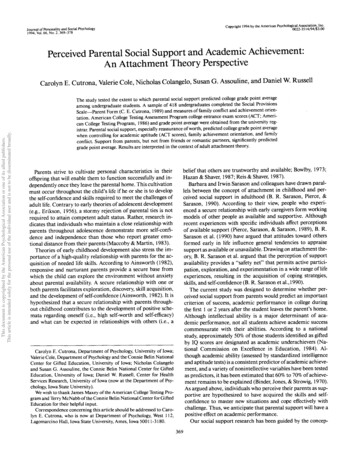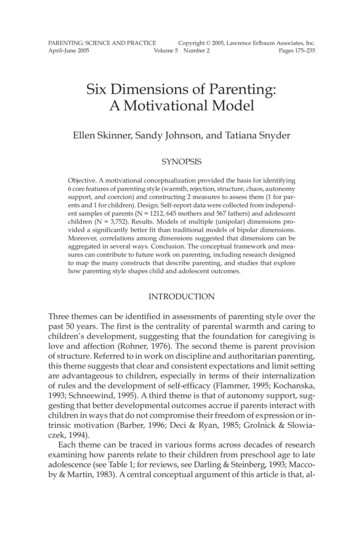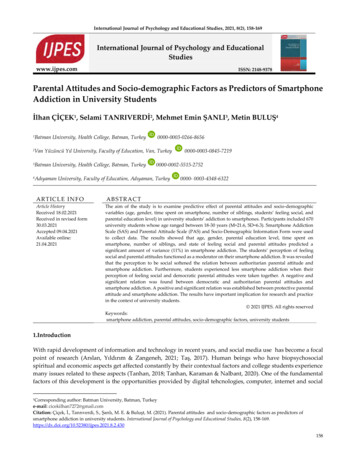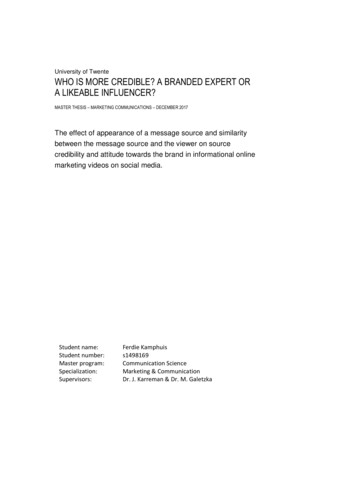
Transcription
Copyright 1994 by the American Psychological Association, Inc.Journal of Personality and Social Psychology1994, Vol. 66, No. 2, 369-378Perceived Parental Social Support and Academic Achievement:An Attachment Theory PerspectiveThis document is copyrighted by the American Psychological Association or one of its allied publishers.This article is intended solely for the personal use of the individual user and is not to be disseminated broadly.Carolyn E. Cutrona, Valerie Cole, Nicholas Colangelo, Susan G. Assouline, and Daniel W. RussellThe study tested the extent to which parental social support predicted college grade point averageamong undergraduate students. A sample of 418 undergraduates completed the Social ProvisionsScale—Parent Form (C. E. Cutrona, 1989) and measures of family conflict and achievement orientation. American College Testing Assessment Program college entrance exam scores (ACT; American College Testing Program, 1986) and grade point average were obtained from the university registrar. Parental social support, especially reassurance of worth, predicted college grade point averagewhen controlling for academic aptitude (ACT scores), family achievement orientation, and familyconflict. Support from parents, but not from friends or romantic partners, significantly predictedgrade point average. Results are interpreted in the context of adult attachment theory.Parents strive to cultivate personal characteristics in theiroffspring that will enable them to function successfully and independently once they leave the parental home. This cultivationmust occur throughout the child's life if he or she is to developthe self-confidence and skills required to meet the challenges ofadult life. Contrary to early theories of adolescent development(e.g., Erikson, 1956), a stormy rejection of parental ties is notrequired to attain competent adult status. Rather, research indicates that individuals who maintain a close relationship withparents throughout adolescence demonstrate more self-confidence and independence than those who report greater emotional distance from their parents (Maccoby & Martin, 1983).Theories of early childhood development also stress the importance of a high-quality relationship with parents for the acquisition of needed life skills. According to Ainsworth (1982),responsive and nurturant parents provide a secure base fromwhich the child can explore the environment without anxietyabout parental availability. A secure relationship with one orboth parents facilitates exploration, discovery, skill acquisition,and the development of self-confidence (Ainsworth, 1982). It ishypothesized that a secure relationship with parents throughout childhood contributes to the development of positive schemata regarding oneself (i.e., high self-worth and self-efficacy)and what can be expected in relationships with others (i.e., aCarolyn E. Cutrona, Department of Psychology, University of Iowa;Valerie Cole, Department of Psychology and the Connie Belin NationalCenter for Gifted Education, University of Iowa; Nicholas Colangeloand Susan G. Assouline, the Connie Belin National Center for GiftedEducation, University of Iowa; Daniel W. Russell, Center for HealthServices Research, University of Iowa (now at the Department of Psychology, Iowa State University).We wish to thank James Maxey of the American College Testing Program and Terry McNabb of the Connie Belin National Center for GiftedEducation for their helpful input.Correspondence concerning this article should be addressed to Carolyn E. Cutrona, who is now at Department of Psychology, West 112,Lagomarcino Hall, Iowa State University, Ames, Iowa 50011-3180.belief that others are trustworthy and available; Bowlby, 1973;Hazan & Shaver, 1987; Reis & Shaver, 1987).Barbara and Irwin Sarason and colleagues have drawn parallels between the concept of attachment in childhood and perceived social support in adulthood (B. R. Sarason, Pierce, &Sarason, 1990). According to their view, people who experienced a secure relationship with early caregivers form workingmodels of other people as available and supportive. Althoughrecent experiences with specific individuals affect perceptionsof available support (Pierce, Sarason, & Sarason, 1989), B. R.Sarason et al. (1990) have argued that attitudes toward othersformed early in life influence general tendencies to appraisesupport as available or unavailable. Drawing on attachment theory, B. R. Sarason et al. argued that the perception of supportavailability provides a "safety net" that permits active participation, exploration, and experimentation in a wide range of lifeexperiences, resulting in the acquisition of coping strategies,skills, and self-confidence (B. R. Sarason et al., 1990).The current study was designed to determine whether perceived social support from parents would predict an importantcriterion of success, academic performance in college duringthe first 1 or 2 years after the student leaves the parent's home.Although intellectual ability is a major determinant of academic performance, not all students achieve academic successcommensurate with their abilities. According to a nationalstudy, approximately 50% of those students identified as giftedby IQ scores are designated as academic underachievers (National Commission on Excellence in Education, 1984). Although academic ability (assessed by standardized intelligenceand aptitude tests) is a consistent predictor of academic achievement, and a variety of nonintellective variables have been testedas predictors, it has been estimated that 60% to 70% of achievement remains to be explained (Binder, Jones, & Strowig, 1970).As argued above, individuals who perceive their parents as supportive are hypothesized to have acquired the skills and selfconfidence to master new situations and cope effectively withchallenge. Thus, we anticipate that parental support will have apositive effect on academic performance.Our social support research has been guided by the concep369
This document is copyrighted by the American Psychological Association or one of its allied publishers.This article is intended solely for the personal use of the individual user and is not to be disseminated broadly.370CUTRONA, COLE, COLANGELO, ASSOULINE, RUSSELLtual framework of Robert Weiss (1974), who proposed six "provisions" that may be derived from relationships with others.These include guidance (advice and information), reliable alliance (tangible aid), attachment (expressions of caring and love),reassurance of worth (respect for abilities and personal qualities), and social integration (mutual interests and concerns andbelonging to a group of similar others). A final component inWeiss's (1974) list of social provisions is opportunity to providenurturance, which refers to the extent to which the target personis a source of support to others.A small number of studies have documented links betweenperceived social support and performance on academic or academic-like tasks. Subjects high in perceived social support performed better on a difficult anagram task than did subjects lowin social support. Subjects high in social support also reportedless cognitive interference, concentrated more on performingthe task, and reported fewer interfering thoughts and worriesduring the task (I. G. Sarason, Sarason, Keefe, Hayes, &Shearin, 1986). In a study offirst-and second-year cadets at theU.S. Coast Guard Academy, high interpersonal stress with peersweakened the association between intellectual aptitude (Scholastic Aptitude Test Mathematics scores) and classroom grades(Barnes, Potter, & Fiedler, 1983). Among students who reporteda large number of peer-related stressful events (and presumablylow perceived peer support), high intellectual ability frequentlywas not translated into good grades. Among cadets who reported high stress in their relationship with their parents, firstand second-year grades were lower than those of cadets who reported lower levels of stress in their relationship with parents.Purpose of the StudyUndergraduates were assessed at the beginning of the semester regarding perceived social support. Their college entranceexam scores (American College Testing Assessment Programcollege entrance exam [ACT]; American College Testing Program, 1986) and cumulative grade point averages (GPAs) wereobtained from the registrar the following semester. This enabledus to assess the relation between perceived social support andGPA while statistically controlling for academic aptitude. Thefirst study assessed only perceived support from parents on thebasis of theoretical links between early parent-child attachmentand perceived parental support in adulthood. We conductedanalyses to determine which of six components of parental support were most closely linked to students' academic performance. In addition, we conducted analyses to determine the specificity of the relation between parental social support and grades.In our analyses, we controlled for level of family conflict. It hasbeen argued that measures of perceived social support may, infact, reflect the absence of aversive interactions rather than theoccurrence of supportive interactions (Coyne, Ellard, & Smith,1990). Controlling for family conflict allowed us to determinewhether the link between perceived social support and academic performance would retain significance when controllingfor negative aspects of family relations. In addition, we controlled for parental achievement orientation. Parental valuesthat emphasize winning, success, doing one's best, persistence,excellence, and productivity have been associated with academic achievement (Bloom, 1985; Rimm, 1991). We reasonedthat these values and behaviors might covary with parental supportiveness and wanted to discover whether controlling for parental academic orientation would weaken the link between parental social support and academic achievement.In the second study, we broadened our assessment of perceived support to include two additional sources: friends andromantic partners. Although a history of interaction with supportive parents was hypothesized to play a key role in the formation of self-confidence and coping skills, it was anticipatedthat the quality of support received from peers and romanticpartners would enhance well-being and would add to the explained variance in academic performance, although these relations were not expected to be as strong as that for parents.An exploratory analysis was conducted to uncover potentialmediating variables in the relation between parental social support and academic performance. According to attachment theory, a secure, supportive relationship with parents should leadto low anxiety and willingness to explore the environment(Ainsworth, 1982). Successful exploration should be associatedwith the development of self-confidence. We reasoned that individuals who have experienced a lifetime of secure and supportive parenting would experience low anxiety, which would allowthem to take advantage of opportunities to obtain needed skills,competencies, and self-confidence. Although a range of positiveself-appraisals are probably produced in this manner, we reasoned that academic self-appraisal would be most closely linkedto academic performance.Individuals with high self-efficacy beliefs, that is, those whobelieve that they can perform behaviors required to achieve specific valued goals, have been shown to demonstrate greater persistence, willingness to tackle difficult tasks, and avoidance ofself-blaming attributions for failure (Bandura, 1982). Amongscience and engineering majors, academic self-efficacy was a significant predictor of college grade point average when controlling for aptitude as assessed by college entrance exam scores(Brown, Lent, & Larkin, 1989). Thus, we predicted that selfefficacy in the academic domain would be a significant predictor of actual GPA. To summarize, we hypothesized that parental social support would predict low anxiety, which would inturn predict academic self-efficacy. We predicted that academicself-efficacy would contribute to better performance in theclassroom, as measured by GPA.Study 1MethodParticipants and ProcedureParticipants were undergraduates at the University of Iowa, all ofwhom were enrolled in an introductory psychology course. Studentsearned partial course credit for participating in a 1-hr group testingsession in which they completed a large set of measures, most of whichwere unrelated to the current study. For the purpose of the currentstudy, questionnaires were administered assessing perceived social support from parents, family conflict, and parental achievement orientation. In addition, students were asked to provide written permission forthe investigators to obtain their most recent scores on the ACT (American College Testing Program, 1986) and their University of Iowa cumulative GPA, (to be obtained the following semester) from the universityregistrar. By limiting the data to University of Iowa GPAs, we hoped to
371SOCIAL SUPPORT AND ACHIEVEMENTeliminate variation due to grades transferred from other colleges withdiffering grade distributions and standards. Of the 554 students whoparticipated in the group testing session, 452 (82%) gave their consent.Complete data were obtained for 418 students (234 women, 165 men,and 19 who did not indicate their gender). Year in school was not obtained from students. However, all subjects were currently enrolled inintroductory psychology, and during the semester when the data werecollected, 59% of those enrolled were freshmen, 26% were sophomores,and 15% were juniors or seniors. Historically, the class distribution ofstudents who participate in the group assessment program is very similar to that for the class as a whole.This document is copyrighted by the American Psychological Association or one of its allied publishers.This article is intended solely for the personal use of the individual user and is not to be disseminated broadly.MeasuresAcademic ability. Academic ability was assessed by scores on theACT exam. The ACT (American College Testing Program, 1986) is thesecond most widely used college admissions test, administered to morethan one million students each year. It is the primary college entranceexam taken by Iowa students. The academic tests for the 1988-89 ACTincluded the English Usage Test, the Mathematics Usage Test, the SocialStudies Reading Test, and the Natural Sciences Reading Test.The ACT academic tests yield standard scores of I to 36 that areaveraged to create the ACT Composite. Internal consistency reliabilitiesfor the tests are quite good, ranging from .85 to .92. The compositetypically correlates .40 to .50 with freshman GPA (Kifer, 1985), although the correlations vary as a function of college, ranging from .29to .80 (Munday, 1970).Social support. The Social Provisions Scale—Parent Version wasused to assess parental social support (SPS-P; Cutrona, 1989; Cutrona& Russell, 1987). The SPS was designed to tap the six provisions ofsocial relationships identified by Weiss (1974). The six provisions assessed are guidance (advice and information), reliable alliance (tangibleassistance), attachment (caring), social integration (similarity of interests and concerns), reassurance of worth (positive evaluation of skillsand abilities), and opportunity to provide nurturance (providing support to others). In the SPS-P, each provision is assessed by two items,one that describes the presence and one that describes the absence ofthe provision in the student's relationship with his or her parents, for atotal of 12 items. Reliability for the scale ranges from .81 to .91 across arange of samples (Cutrona, 1989; Cutrona & Russell, 1987). Extensivevalidity evidence for the SPS among both adult and adolescent populations has been presented elsewhere (Cutrona, 1989; Cutrona & Russell,1987). Coefficient alpha for the total SPS-P was .81 in the current study.Alpha coefficients for the two-item provision subscales ranged from .47(opportunity to provide nurturance) to .72 (attachment).Family conflict and parental achievement orientation. Both familyconflict and achievement orientation were assessed with subscales of thewidely used Family Environment Scale (Moos & Moos, 1986). Internalconsistency of .75 and 2-month test-retest reliability of .85 have beenreported for the Conflict scale. For the Achievement Orientation scale,internal consistency of .65 and test-retest reliability of .74 have beenreported (Moos & Moos, 1986). Extensive validity evidence has beenreported for all subscales of the Family Environment Scale (summarized in Moos & Moos, 1986)ResultsDescriptive StatisticsTable 1 provides means and standard deviations for all studyvariables. The mean ACT score for this sample (N 418, M 23.70) was significantly higher than the national mean of 21.1for college freshmen, /(417) 14.14, p .01. Thus, results mustbe interpreted with the understanding that the lower range ofTable 1Means and Standard Deviationsfor Study 1 Achievement,Personal, and Family VariablesMeasureMSDPossible rangeACT exam scoreGrade point averageTotal parental social supportSocial support subscaleReassurance of WorthReliable AllianceGuidanceSocial IntegrationNurturanceAttachmentFamily Environment ScaleConflictAchievement 82-82-812.9415.162.361.679-189-18.664.32.60Note. ACT American College Testing Assessment.scores was underrepresented in our sample, which may lowercorrelations between the ACT and other variables. Means forsocial support, conflict, and achievement orientation were comparable with published norms for similar populations (Cutrona& Russell, 1987; Moos & Moos, 1986).Causal Modeling AnalysisStructural equation analysis with latent variables was used totest the causal model shown in Figure 1, as operationalized bythe maximum likelihood methods of LISREL VII (Joreskog &Sorbom, 1989). To evaluate the fit of a causal model to the data,the LISREL program provides a chi-squared test that reflects theextent to which the hypothesized model is able to account forrelations among the variables. Because the chi-squared goodnessof-fit statistic is sensitive to sample size and violations of the assumption of multivariate normality, evaluation of model fit wasbased on considerations beyond the statistical significance of thechi-squared. We relied on the Goodness of Fit Index (GFI) reported by LISREL VII. GFI represents the proportion of variances and covariances of the variables being analyzed that is explained by the causal model (Tanaka & Huba, 1985). This statistic represents a multivariate extension of the R2 values derivedfrom a multiple regression analysis. Values of GFI can range between 0 and 1.0, with values of .90 or greater generally indicatinga model that accounts for the data well (Tanaka, 1987).Testing the Causal ModelBecause multiple indicators of ACT scores and GPA were notobtained, these two variables were specified as manifest variables. Only parental social support, family conflict, andachievement orientation were specified as latent variables. Thesix subscales of the SPS-P were used to operationalize the latentparental social support variable. All of the six subscales' factorloadings on the social support latent variable were highly significant. Items on the family conflict scale were randomly divided into three subscales, each of which was used as an indicator of the latent conflict variable. All of the subscales' factor
This document is copyrighted by the American Psychological Association or one of its allied publishers.This article is intended solely for the personal use of the individual user and is not to be disseminated broadly.372CUTRONA, COLE, COLANGELO, ASSOULINE, RUSSELLParentalAchievementOrientationFigure 1. The model testing the significance of parental social support, family conflict, and parentalachievement orientation, controlling for American College Testing Assessment (ACT) scores, in the prediction of college grade point average. * p .05. ** p .01.loadings on the conflict latent variable were highly significant.We attempted to follow the same procedure for the achievementorientation subscale. However, surprisingly low interitem correlations were found for the scale in our sample (Cronbach's a .45). We selected the three items with intercorrelations greaterthan .20 and used each as an indicator of the achievement orientation construct. Each item loaded significantly on theachievement orientation latent factor. Results for achievementorientation should be viewed with caution in light of the smallnumber of items used to operationalize the latent variable. Table 2 contains the correlations among all manifest and latentvariables included in the model.Figure 1 presents the results of testing the causal model. ThisTable 2Correlations Among Study 1 Latent and Measured t orientationParental supportACT11-.06-.09.14*.28*model was found to fit the data well, x2(69, N 418) 127.48,p .001, GFI .958. As shown in Figure 1, high school ACTscores and current social support were both significant predictorsof GPA. Neither family conflict nor parental achievement orientation achieved significance as a predictor of GPA. All of the variables together accounted for 11.0% of the variation in the following semester's cumulative GPA. A "trimmed" model that included only parental social support and ACT scores predictingGPA was tested next. These two variables together accounted for9.9% of the variance in GPA. The fit of the model was good anddid not show significant decline with the elimination of the conflict and achievement variables, x2(71, iV 418) 130.14, p .001, GFI .957. Unique variance proportions attributable toACT and parental support were 8.2% and 2.3%, respectively.1Having demonstrated a significant relation between the generalsocial support factor and GPA, it was of interest to determine—.14*-.50**-.04—.04-.04—-.06Note, n 418. GPA grade point average; ACT American CollegeTesting Assessment, composite score.*/ .05. **p .001.We computed the unique variation explained by each of the twopredictor variables by testing models that eliminated each predictorvariable and then compared the R2 value associated with that reducedmodel with the R2 associated with the full model. So, for example, theunique variation explained by parental support was calculated by comparing the R2 value associated with the full model (i.e., that includedACT and parental support as predictor variables) with the R2 associatedwith the model that only used ACT as a predictor of GPA. The uniquevariation attributable to ACT scores was determined in the same way.Using this procedure, the variance uniquely accounted for by social
373This document is copyrighted by the American Psychological Association or one of its allied publishers.This article is intended solely for the personal use of the individual user and is not to be disseminated broadly.SOCIAL SUPPORT AND ACHIEVEMENTOpportunityto ProvideNurturanccFigure 2. The model testing the significance of separate components of parental social support in theprediction of college grade point average, controlling for American College Testing Assessment (ACT)scores. GPA grade point average. * p .05. ** p .01.which of the individual social support components was moststrongly predictive. In this model, individual paths from each provision subscale to GPA were hypothesized, as well as the path fromACT score to GPA. In the model, all subscales were allowed tocorrelate with each other, reflecting known interrelations amongsocial support components. Thus, all possible paths were includedin the model. The chi-squared test is not meaningful in this case(x2 1.00), but it was of interest to investigate the extent to whichspecific paths in the model attained significance. Results of thisanalysis are shown in Figure 2. In addition to the path betweenACT and GPA, which was highly significant, significant paths werefound for both reassurance of worth and social integration. Students whose parents expressed belief in their competence and abilities and who shared the students' interests and concerns weremore likely to perform well in college than those whose parents didnot demonstrate these attributes. None of the other paths linkingsupport components to GPA attained significance. The ACT andsocial support variables together accounted for 13.4% of the variation in GPA.Gender DifferencesAnalyses were also conducted to test for sex differences in thepath coefficients linking the predictor variables to GPA, usingthe multiple group option in the LISREL program. For thepurposes of these analyses, the measurement models (i.e., theloadings of the measured variables on the latent variables) wereconstrained to be equal for men and women. The fit of a modelthat constrained the path coefficients to be equal for the twosexes was then compared with the fit of a model that allowed thepath coefficients to vary by sex, using a chi-squared differencetest (Bentler & Bonnet, 1980). The results of this comparisonwere nonsignificant, x 2 (4) 0.20. Therefore, we can concludethat the path coefficients for the model are not significantlydifferent for male and female students.Study 2support and ACT sums to slightly more than the total variance explained by the model. This reflects a suppressor effect (Pedhazur, 1982),in which the two predictor variables appear jointly to explain less variation in the dependent variable than each variable does uniquely.MethodParticipants and ProceduresParticipants were recruited the following academic year from thesame source (introductory psychology class), using the same procedures
374CUTRONA, COLE, COLANGELO, ASSOULINE, RUSSELLas reported in Study 1. Similarly, students' ACT scores and next-semester cumulative University of Iowa GPAs were obtained, with the students' written consent, from the registrar. Complete data were obtainedfrom 378 subjects.The path between ACT and GPA was once again significant. In addition, the paths linking parental reassurance of worth and opportunityto provide nurturance to GPA were significant. Parental reassuranceof worth, that is, belief in one's competence and abilities, was also asignificant predictor of GPA in Study 1.This document is copyrighted by the American Psychological Association or one of its allied publishers.This article is intended solely for the personal use of the individual user and is not to be disseminated broadly.MeasuresBecause they did not attain significance in Study 1, the Conflict andAchievement Orientation scales were not administered in Study 2. Totest the relative contribution of perceived social support from differentsources, the entire Source Specific version of the SPS (SPS-SS; Cutrona,1989) was administered, rather than the SPS-P alone. The full SPS-SSincludes 36 items. Twelve items assess perceived support from each ofthree sources: parents, friends, and romantic partners. Coefficient alphafor the three source subscales were .86, .86, and .88, respectively. Coefficient alphas for the two-item individual provision subscales rangedfrom .54 to .77.Gender DifferencesUsing the same procedures as were used in Study 1, analyses wereconducted that tested whether the path coefficients linking the predictorvariables to GPA were significantly different for male and female students. Once again, the results of the chi-squared difference test werenonsignificant, x2(4) 2.49, indicating that the path coefficients didnot vary by sex.Study 3Testing the Causal ModelsMethodOnce again, GPA and ACT scores were treated as manifest variables.In the first model to be tested, three latent variables were operationalized to reflect social support from each of three sources: parents,friends, and romantic partners. The six provision subscales for eachsource were used to operationalize the latent support factor for eachsource. Each subscale loaded significantly on the appropriate latentvariable. Correlations among all manifest and latent variables includedin the model are shown in Table 3. In this model, correlated measurement error was included in the model between measures of the sametype of support across sources (e.g., guidance from parents, friends, andromantic partner). A model was tested in which ACT scores and support from each of the three sources predicted GPA. (See Figure 3.) Themodel was a good fit to the data, x2(155, N 378) 374.09, p .001,GFI .91. In addition to the significant path between ACT score andGPA, the only other significant path was that between parental socialsupport and GPA. Neither friend support nor romantic partner supportwas significantly predictive of GPA. Together, the variables in the modelaccounted for 15.1 % of the variance in GPA.Given that only parental support was significantly related to GPA,an analysis was conducted to determine which components of parentalsocial support were most strongly predictive of GPA. This was a replication of the model tested in Study 1. The parental support componentsubscales and ACT were tested as predictors of GPA. Once again, all ofthe parental support components were allowed to intercorrelate. Because all possible paths were included in the model, the chi-squared testwas not informative. The predictor variables accounted for 18.1 % of thevariability in GPA. Of this, 15.1% was attributable to ACT score and5% was attributable to parental social support.2Table 3Correlations Among Study 2 Latent and Measured ConstructsConstruct1. GPA2. ACTSupport from3. Parents4. Friends5. Romantic *Participants and ProcedureParticipants were a subset of those who participated in Study 2. Allstudents who participated in the psychology department gr
demic achievement (Bloom, 1985; Rimm, 1991). We reasoned that these values and behaviors might covary with parental sup-portiveness and wanted to discover whether controlling for pa-rental academic orientation would weaken the link between pa-rental social support and academic achievement. In the second study, we broadened our assessment of per-










